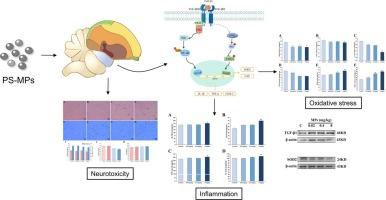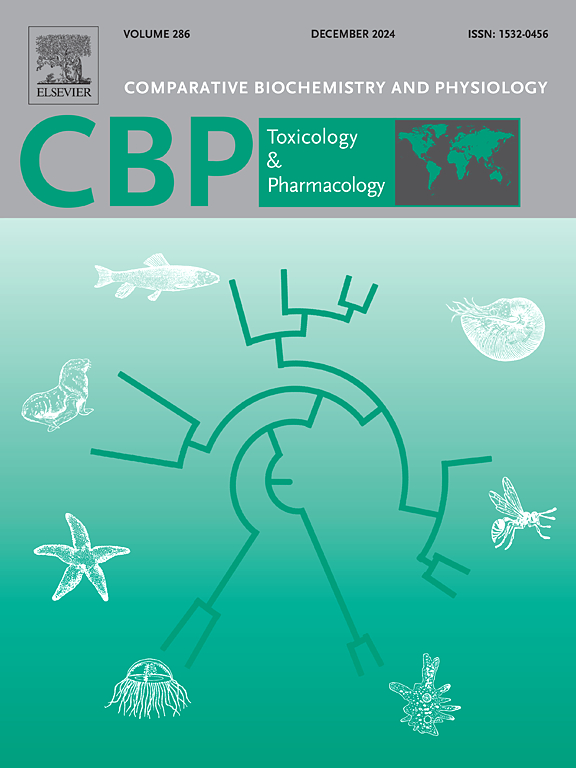The effects of microplastics exposure on quail's hypothalamus: Neurotransmission disturbance, cytokine imbalance and ROS/TGF-β/Akt/FoxO3a signaling disruption
IF 3.9
3区 环境科学与生态学
Q2 BIOCHEMISTRY & MOLECULAR BIOLOGY
Comparative Biochemistry and Physiology C-toxicology & Pharmacology
Pub Date : 2024-10-21
DOI:10.1016/j.cbpc.2024.110054
引用次数: 0
Abstract
Microplastics (MPs) have become a major focus of environmental toxicology, raising concerns about their potential adverse effects on animal organs and body systems. As these tiny particles infiltrate ecosystems, they may pose risks to the health of organisms across diverse species. In this study, we attempted to examine the neurotoxic effects of MPs exposure on avian hypothalamus by using an animal model-Japanese quail (Coturnix japonica). The quails of 7-day-old were exposed to 0.02 mg/kg, 0.4 mg/kg and 8 mg/kg polystyrene microplastic (PS-MPs) of environmental relevance for 35 days. The results showed PS-MPs exposure did damages to hypothalamic structure characterized by neuron malformation, irregular arrangement and cellular vacuolation after 5-week exposure. PS-MPs exposure also induced Nissl body reduction and dissolution in the hypothalamus. Moreover, the decrease of acetylcholinesterase (AchE) activity and increasing acetylcholine (Ach) indicated that PS-MPs exposure caused hypothalamic neurotransmission disturbance. PS-MPs exposure also led to neuroinflammation by disrupting the balance between proinflammatory and anti-inflammatory cytokines. Moreover, increasing reactive oxygen species (ROS) and malondialdehyde (MDA) generation with reducing antioxidants indicated PS-MPs led to hypothalamic oxidative stress. Additionally, RNA-Seq analysis found that both transforming growth factor-β (TGF-β) signaling and forkhead box O (FoxO) signaling were disturbed in the hypothalamus by PS-MPs exposure. Especially, the increasing ROS led to TGF-β activation and then induced hypothalamic inflammation by nuclear factor κB (NF-κB) activation. The present study concluded that oxidative stress might be an important mechanistic signaling involved in MPs neurotoxicology.

微塑料暴露对鹌鹑下丘脑的影响:神经传递紊乱、细胞因子失衡和ROS/TGF-β/Akt/FoxO3a信号转导破坏。
微塑料(MPs)已成为环境毒理学的一大焦点,引起了人们对其对动物器官和身体系统的潜在不利影响的关注。随着这些微小颗粒渗入生态系统,它们可能会对不同物种的生物体健康造成危害。在这项研究中,我们试图利用一种动物模型--日本鹌鹑(Coturnix japonica)来研究暴露于 MPs 对鸟类下丘脑的神经毒性影响。7 日龄的鹌鹑分别暴露于 0.02 毫克/千克、0.4 毫克/千克和 8 毫克/千克与环境相关的聚苯乙烯微塑料(PS-MPs)中 35 天。结果表明,接触 PS-MPs 5 周后,下丘脑结构受损,表现为神经元畸形、排列不规则和细胞空泡化。接触 PS-MPs 还导致下丘脑中的 Nissl 体减少和溶解。此外,乙酰胆碱酯酶(AchE)活性的降低和乙酰胆碱(Ach)的增加表明,接触 PS-MPs 会导致下丘脑神经传递紊乱。接触 PS-MPs 还会破坏促炎和抗炎细胞因子之间的平衡,从而导致神经炎症。此外,活性氧(ROS)和丙二醛(MDA)生成量的增加以及抗氧化剂的减少表明,PS-MPs 会导致下丘脑氧化应激。此外,RNA-Seq 分析发现,下丘脑中的转化生长因子-β(TGF-β)信号传导和叉头框 O(FoxO)信号传导都受到了 PS-MPs 暴露的干扰。特别是,ROS 的增加导致 TGF-β 激活,然后通过核因子κB(NF-κB)激活诱发下丘脑炎症。本研究认为,氧化应激可能是参与 MPs 神经毒理学的一个重要机制信号。
本文章由计算机程序翻译,如有差异,请以英文原文为准。
求助全文
约1分钟内获得全文
求助全文
来源期刊
CiteScore
7.50
自引率
5.10%
发文量
206
审稿时长
30 days
期刊介绍:
Part C: Toxicology and Pharmacology. This journal is concerned with chemical and drug action at different levels of organization, biotransformation of xenobiotics, mechanisms of toxicity, including reactive oxygen species and carcinogenesis, endocrine disruptors, natural products chemistry, and signal transduction with a molecular approach to these fields.

 求助内容:
求助内容: 应助结果提醒方式:
应助结果提醒方式:


